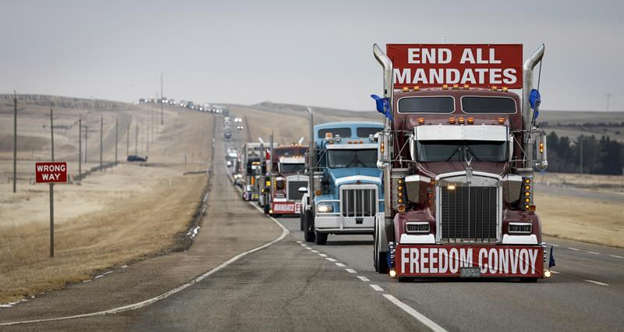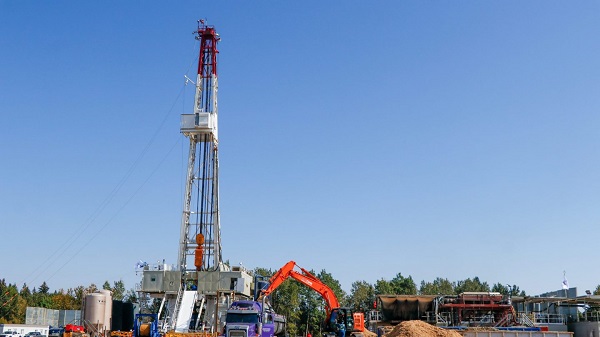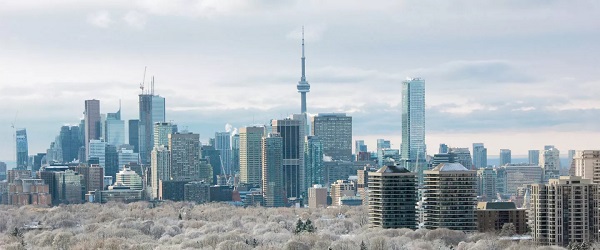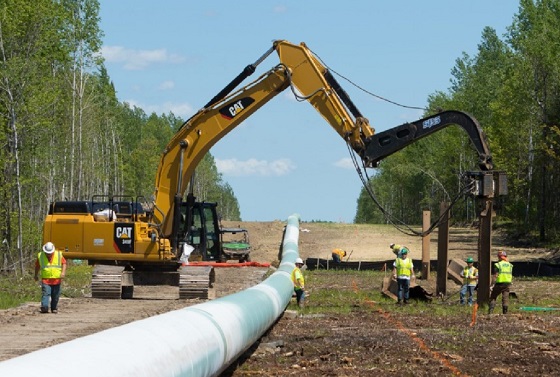Alberta
‘It could have been deadly’: Truckers end blockade at Alberta border crossing

COUTTS, Alta. — A blockade that paralyzed a United States border crossing for more than two weeks ended Tuesday as trucks and other vehicles with horns blaring rolled away from a southern Alberta community.
Protesters had been restricting access to the busy crossing near Coutts since Jan. 29 to rally against COVID-19 vaccine mandates for truckers and broader pandemic health restrictions.
Canada Border Services Agency said operations had resumed at the crossing and RCMP confirmed later Tuesday that traffic was moving smoothly.
The exodus of vehicles came one day after RCMP arrested 13 people and seized a cache of firearms and ammunition.
Charges laid include possession of weapons and mischief to property.
Four people also face a charge of conspiracy to murder RCMP members, said Chief Supt. Trevor Daroux. He said police worked closely with the Crown to ensure they had the necessary evidence to lay those charges.
Some of the accused were granted release in a Lethbridge, Alta., courtroom on Tuesday. A judge also ordered that they can’t contact one another or be within a 200-metre radius of any protest.
Mounties said an early-morning raid Monday uncovered 13 long guns, handguns, a machete, a large quantity of ammunition and body armour. Two additional weapons were seized later in the day.
RCMP also said a semi-truck and farm tractor had attempted to ram a police cruiser on Sunday.
“The dangerous criminal activity occurring away from the TV cameras and social media posts was real and organized,” said Deputy Commissioner Curtis Zablocki on Tuesday evening.
“It could have been deadly for citizens, protesters and officers.”
Daroux said the RCMP became aware of the heavily armed group a few days after the protest began. He said investigations are ongoing into this group and other events that took place during the blockade.
“Alberta RCMP will remain in the area until we are confident that the situation is safe and stabilized for all who travel through here,” he said.
Protesters are dissociating themselves from the group of people facing serious charges. Organizer Marco Van Huigenbos said that is why the convoy decided to leave peacefully.
He said he has no regrets about participating in the blockade.
“I think we’ve started a movement where people are going to get more involved … at the municipal level, provincial possibly, but also more involvement in politics in general.”
Two tactical vests seized by the RCMP had badges on them, which the Canadian Anti-Hate Network said have links to troubling movements.
One vest had a “Diagolon” patch on it, a white diagonal line across a black rectangle, that is linked to an often conspiratorial and antisemitic group, said Peter Smith from the network. He said the group often talks about a soon-approaching civil war.
“(Their) rhetoric is very violent,” said Smith. “One of the, kind of, common phrases used within the community is ‘A gun or rope?'”
The other patch said “Infidel” in both English and Arabic in yellow. Smith said the patch doesn’t indicate membership to a specific network but is known among Islamophobic militias and biker-style hate groups.
He said the biggest worry is having niche extremist networks that could work to inflame supporters linked to what was supposed to be a peaceful protest.
There was celebrating when the protest started winding down late Monday. A video posted to social media showed RCMP members shaking hands with and hugging protesters. People holding hats or hands to their chests or with arms draped across each other’s shoulders sang O Canada.
Cpl. Gina Slaney confirmed the scene was from Monday night in Coutts.Zablocki said RCMP is aware of the video.
“I will say, we do encourage our members to engage with the public and develop respectful, professional relationships with all Albertans,” said Zablocki. “We will be looking further into this matter.”
Jim Willett, mayor of the village of 250 people, said it had been a while since he had seen anything but semi-trailers on Highway 4.
“I can see all the way to Regina,” he said with a laugh.
Willett said he doesn’t blame the blockade leaders for the cache of weapons.
“They were a well-behaved bunch of people,” he said. “I think the organizers were taken aback as much as we were by what the RCMP discovered.”
The number of protesters at a police checkpoint, north of Coutts, had also dwindled and work was underway to start clearing away a first-aid trailer, a sauna and electric generators.
“Last night, emotions were high … I think a lot of people felt that we were giving up, but we’re not giving up,” said John Vanreeuwyk, a feedlot operator from Coaldale, Alta., also a protest organizer.
“Is it a victory? No. A victory means we’re done,” he said.
The blockade was one of several demonstrations in Canadian cities and border points that stalled trade, stranded travellers and disrupted lives of area residents, particularly in Ottawa.
Deputy Prime Minister Chrystia Freeland has said $48 million in trade was lost each day that the Coutts border was closed.
— With files from Alanna Smith in Calgary
This report by The Canadian Press was first published Feb. 15, 2022.
Bill Graveland, The Canadian Press
Alberta
Alberta will defend law-abiding gun owners who defend themselves

Alberta’s government will introduce a motion under the Alberta Sovereignty within a United Canada Act to defend law-abiding firearms owners.
A new motion under the Alberta Sovereignty within a United Canada Act will, if passed by the legislature, instruct all provincial entities, including law-enforcement agencies such as municipal police services and the RCMP, to decline to enforce or implement the federal gun seizure program. The motion also makes clear that Albertans have the right to use reasonable force to defend themselves, their families and their homes from intruders.
This builds on the steps Alberta has already taken to reduce crime, strengthen public safety and assert provincial jurisdiction over firearms. This includes passing the Alberta Firearms Act to establish the Alberta Chief Firearms Office, along with the Alberta Firearms Regulation and the Seizure Agent and Provider Licensing Regulation.
“It’s time for Ottawa to stop targeting the wrong people. Albertans have the right to protect their homes and their families. No one should hesitate to defend themselves when faced with a threat at their own doorway. Law-abiding citizens, hunters, farmers and sport shooters are not the source of violent crime, yet the federal government wants to confiscate their property while illegal guns pour across our borders. Alberta will not stand by while responsible gun owners are treated like criminals. This motion is about using every legal tool we have to protect their rights, uphold public safety and push back on federal overreach into provincial jurisdiction.”
“When someone breaks into your home, the law recognizes that you have enhanced rights to protect yourself and your family. Alberta is making that principle unmistakably clear: lawful, reasonable self-defence will be respected, not criminalized.”
“As an experienced former law enforcement officer, law-abiding gun owners have never been an issue, in my own personal experience, nor has there been any data to support that law-abiding gun owners are the ones that are committing violent gun crimes. The illegal guns that you see being used by criminals are typically being smuggled in from the United States. The federal government should help us strengthen the border, helping us to stop illegal guns from coming into Canada. This would further enhance safety and security for the people of Alberta and Canada as opposed to going after lawful gun owners.”
Under the Alberta Firearms Regulation, municipalities, law enforcement and police commissions must obtain approval from Alberta’s Minister of Justice before accepting funding to participate in the Assault-Style Firearms Compensation Program.
“Misguided federal initiatives such as the handgun transfer ban and the Order in Council firearms prohibitions of 2020, 2024 and 2025 have had a devastating impact on the safe, legitimate activities of the firearms community and the businesses that support it, while having no discernible effect on criminal activity. I am proud to see that the Alberta government is pushing back and supporting lawful firearms owners through these measures.”
“Licensed gun owners and all Albertans can rest assured that their government, under the leadership of the UCP, is laser focused on protecting law abiding citizens while prioritizing real public safety.”
“The Alberta Hunter Education Instructors Association will continue to support our government and the Alberta chief firearms officer in our joint quest to use safety training and education as the key tools to ensure we have safer streets and communities. Safe and responsible use of firearms in Alberta is a key part of our heritage, culture, and our rich and precious heritage.”
Key facts:
- Pursuant to the Attorney General’s recent guidance protocols, Alberta’s prosecutors will decline to prosecute offences under the federal gun seizure program when it is not in the public interest.
- The Attorney General’s recent guidance protocol directs prosecutors to not prosecute home defence offences when it is not in the public interest.
- Total spending on the federal Assault-Style Firearms Compensation Program is expected to exceed $750 million.
- The firearms motion considers the Alberta Bill of Rights, the Constitution Act, 1867 and the Criminal Code.
- Currently 10 per cent of adult Albertans are licenced to use and own firearms. There are 381,900 firearms licences in Alberta.
- Alberta has 638 licensed firearms businesses, 138 shooting ranges and 91 shooting clubs.
Alberta
Emissions Reduction Alberta offering financial boost for the next transformative drilling idea

From the Canadian Energy Centre
$35-million Alberta challenge targets next-gen drilling opportunities
‘All transformative ideas are really eligible’
Forget the old image of a straight vertical oil and gas well.
In Western Canada, engineers now steer wells for kilometres underground with remarkable precision, tapping vast energy resources from a single spot on the surface.
The sector is continually evolving as operators pursue next-generation drilling technologies that lower costs while opening new opportunities and reducing environmental impacts.
But many promising innovations never reach the market because of high development costs and limited opportunities for real-world testing, according to Emissions Reduction Alberta (ERA).
That’s why ERA is launching the Drilling Technology Challenge, which will invest up to $35 million to advance new drilling and subsurface technologies.
“The focus isn’t just on drilling, it’s about building our future economy, helping reduce emissions, creating new industries and making sure we remain a responsible leader in energy development for decades to come,” said ERA CEO Justin Riemer.
And it’s not just about oil and gas. ERA says emerging technologies can unlock new resource opportunities such as geothermal energy, deep geological CO₂ storage and critical minerals extraction.
“Alberta’s wealth comes from our natural resources, most of which are extracted through drilling and other subsurface technologies,” said Gurpreet Lail, CEO of Enserva, which represents energy service companies.
ERA funding for the challenge will range from $250,000 to $8 million per project.
Eligible technologies include advanced drilling systems, downhole tools and sensors; AI-enabled automation and optimization; low-impact rigs and fluids; geothermal and critical mineral drilling applications; and supporting infrastructure like mobile labs and simulation platforms.
“All transformative ideas are really eligible for this call,” Riemer said, noting that AI-based technologies are likely to play a growing role.
“I think what we’re seeing is that the wells of the future are going to be guided by smart sensors and real-time data. You’re going to have a lot of AI-driven controls that help operators make instant decisions and avoid problems.”
Applications for the Drilling Technology Challenge close January 29, 2026.
-

 Energy2 days ago
Energy2 days agoCanadians will soon be versed in massive West Coast LPG mega-project
-

 Daily Caller2 days ago
Daily Caller2 days agoTom Homan Predicts Deportation Of Most Third World Migrants Over Risks From Screening Docs
-

 Daily Caller9 hours ago
Daily Caller9 hours agoTech Mogul Gives $6 Billion To 25 Million Kids To Boost Trump Investment Accounts
-

 Artificial Intelligence2 days ago
Artificial Intelligence2 days ago‘Trouble in Toyland’ report sounds alarm on AI toys
-

 National1 day ago
National1 day agoMedia bound to pay the price for selling their freedom to (selectively) offend
-

 Alberta1 day ago
Alberta1 day agoNew era of police accountability
-

 C2C Journal1 day ago
C2C Journal1 day agoLearning the Truth about “Children’s Graves” and Residential Schools is More Important than Ever
-

 Business10 hours ago
Business10 hours agoRecent price declines don’t solve Toronto’s housing affordability crisis



